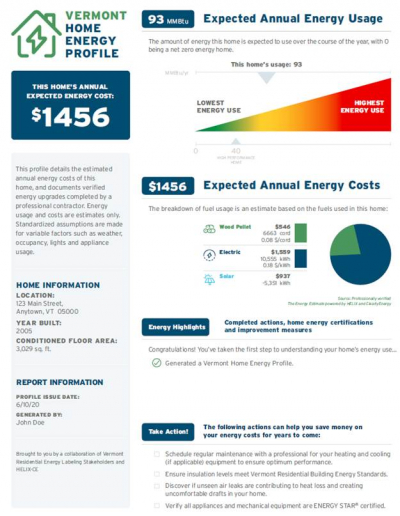

By Carolyn Goldthwaite | Wed, May 19, 21
On Wednesday, May 12, the Montpelier, Vermont City Council voted unanimously to approve a home energy ordinance. The ordinance will require homeowners who are selling their property to disclose, to real estate agents and prospective buyers, their home’s annual energy costs by creating a Vermont Home Energy Profile (VHEP).
What is VHEP?
The Vermont Home Energy Profile (VHEP) is a free, easy-to-use, online tool that generates an energy label unique to each property. A homeowner can fill out the tool in about 10-20 minutes, or the homeowner can authorize a real estate or energy service professional to complete the tool on their behalf. The tool uses information on home energy features to generate a label that displays projected annual energy usage and costs, energy highlights and recommended measures. It also includes the option to supplement with utility bills and information about in-home assets to refine the cost estimate. The label is intended to provide key home energy insights.
So why did they do this? And was this just quick action by the council?
The ordinance is intended to support Montpelier’s Net-Zero Goal by conserving energy, reducing greenhouse gas emissions, and encouraging healthy home environments. It will also create transparency, therefore adding consumer protection to the home buying process. Knowing the potential energy cost of a home and seeing opportunities to improve the efficiency of that home go a long way in creating consumer protections. Home buyers would also have the opportunity to roll energy improvement costs into the mortgage.
Why an Ordinance?
Currently, there is a lack of energy information available for homes. Think about miles-per-gallon (MPG) stickers for vehicles, ENERGY STAR ratings for efficient appliances, and nutrition labels for food. These profiles provide the average consumer with comprehensive information on the energy performance of these products. This is missing for homes.
Buying a home is a huge financial investment – often the single most expensive purchase a person will make. But it also an emotional decision. When buying a home, consumers fall in love with the size of bedrooms, the school district, its walk score, or maybe the tree lined street. Potential buyers can currently sort and filter listings of potential homes for numerous characteristics. Energy features, however, are rarely included in these displays, and so the energy needs of a home are often overlooked. Residential energy labeling fills this gap and informs decision-making by disclosing a home’s energy features, characteristics, and usage to potential buyers, thus helping buyers make informed decisions.
Unanimous by Council, Unanimous by Citizen?
This Ordinance did not get adopted overnight, and was met with opposition by a few concerned citizens. Here are some of the concerns heard during the public meetings:
This will push up home prices, which isn’t consumer protection.
A 2016 study by Elevate Energy found that, on average, homes with high energy costs still had a greater likelihood of selling than those that did not disclose any energy information. There is no available evidence that low-scoring homes are devalued in the same way that high-scoring homes see increased value.
The program will be seen by sellers as a meaningless annoyance. For many, the concern for the sellers outweighed the benefits for the buyers.
A 2020 study from the American Council for an Energy-Efficient Economy (ACEEE) found that participants who were presented with energy information were more likely to choose efficient homes. It also found that Northeast participants were willing to spend about eight percent more on high-efficiency homes. In addition, the study by Elevate Energy shows that homes with disclosed energy costs sold at a higher percentage of their original list price than those that did not disclose (97.2 vs. 95.9 percent).
The program will hurt people who can’t afford energy improvements like solar panels, new windows, and extra insulation.
Home energy labeling empowers customers to make informed decisions about their homes and can help protect residents from burdensome energy costs. The labeling process identifies the most effective efficiency measures for a particular property, assisting the resident in prioritizing measures that will have the biggest impacts on health and cost savings.
The vote was rushed.
To get to this point, Montpelier had to make a change to its Energy Efficiency Charter. The city council approved this measure and, on Town Meeting Day, in 2019 the community voted in favor of this change. The VHEP tool was developed with input from Montpelier and statewide residents - from development, to profile layout, to a pilot test in the fall of 2020. The city took into account stakeholder feedback, made modifications to the ordinance language, and worked with NEEP and ClearlyEnergy to modify VHEP to include features and improved functionality and layout.
This past week, the council amended the proposed ordinance to make it effective immediately on a voluntary basis (instead of the original date of July 1), recognizing the opportunity and need to help their citizens. The council also voted to make VHEP mandatory starting on July 1, 2022, with the penalty for non-compliance capped at a maximum of $500.
Who’s next?
Montpelier isn’t the only community looking at a time-of-listing ordinance. NEEP is currently providing technical assistance to several communities and a few states in our region. Home energy labels can help residents to lower energy bills, which are often one of the largest expenses for homeowners and a burden that disproportionately falls on low-income and historically marginalized homeowners and renters.
We are excited to see who will follow in Montpelier’s footsteps or perhaps walk beside them to create healthier, affordable, efficient homes for all.


